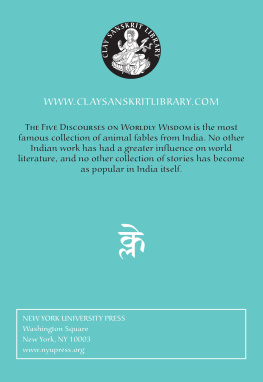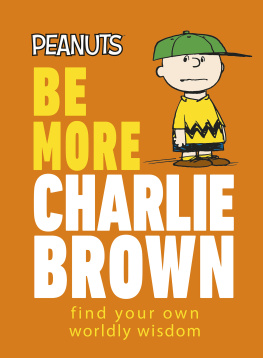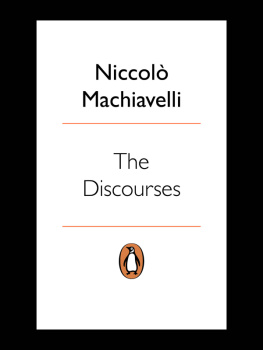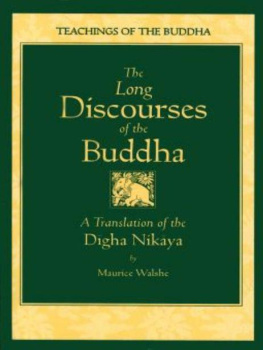Vishnusharman - The Five Discourses on Worldly Wisdom
Here you can read online Vishnusharman - The Five Discourses on Worldly Wisdom full text of the book (entire story) in english for free. Download pdf and epub, get meaning, cover and reviews about this ebook. City: New York, publisher: New York University Press, genre: Children. Description of the work, (preface) as well as reviews are available. Best literature library LitArk.com created for fans of good reading and offers a wide selection of genres:
Romance novel
Science fiction
Adventure
Detective
Science
History
Home and family
Prose
Art
Politics
Computer
Non-fiction
Religion
Business
Children
Humor
Choose a favorite category and find really read worthwhile books. Enjoy immersion in the world of imagination, feel the emotions of the characters or learn something new for yourself, make an fascinating discovery.
- Book:The Five Discourses on Worldly Wisdom
- Author:
- Publisher:New York University Press
- Genre:
- City:New York
- Rating:5 / 5
- Favourites:Add to favourites
- Your mark:
- 100
- 1
- 2
- 3
- 4
- 5
The Five Discourses on Worldly Wisdom: summary, description and annotation
We offer to read an annotation, description, summary or preface (depends on what the author of the book "The Five Discourses on Worldly Wisdom" wrote himself). If you haven't found the necessary information about the book — write in the comments, we will try to find it.
The Five Discourses on Worldly Wisdom — read online for free the complete book (whole text) full work
Below is the text of the book, divided by pages. System saving the place of the last page read, allows you to conveniently read the book "The Five Discourses on Worldly Wisdom" online for free, without having to search again every time where you left off. Put a bookmark, and you can go to the page where you finished reading at any time.
Font size:
Interval:
Bookmark:
All rights reserved.
New York University Press
and the JJC Foundation.
and the rest of the Clay Sanskrit Library
is available on the following websites:
www.claysanskritlibrary.com
www.nyupress.org
ISBN-13: 978-0-8147-6208-0
ISBN-10: 0-8147-6208-5
Typeset in Adobe Garamond at 10.25 : 12.3 + pt.
Printed in Great Britain by St Edmundsbury Press Ltd,
Bury St Edmunds, Suffolk, on acid-free paper.
Bound by Hunter & Foulis, Edinburgh, Scotland.
Visnusarman
[Pancatantra. English & Sanskrit]
The five discourses on worldly wisdom / by Visnusarman ;
translated by Patrick Olivelle. st ed.
p. cm. (The Clay Sanskrit library)
In English and Sanskrit (romanized) on facing pages;
includes translations from Sanskrit.
Includes bibliographical references and index.
ISBN- 13: 978-0-8147-6208-0 (cloth : alk. paper)
ISBN- 10: 0-8147-6208-5 (cloth : alk. paper)
.Fables, IndicTranslations into English.
I. Title: Five discourses on worldly wisdom.
II. Olivelle, Patrick. III. Panchatantra. IV. Title. V. Series.
PK 3798 .VP 3613 2006
891.2 dc 22 2006005181
Jackal
to a Bug
Killed
Quick-witted, and Inevitable
Chicks
for Sesame
a Bowstring
the C rows and the O wls
the Cat
Foolish Husband
a Snake
or English p re tty
nunciation
ciation; Italian s o lo
ceding vowel
tion (resembling English
h ), or like Scottish lo ch , or
an aspiration with a faint
echoing of the preceding
nounced taih i
tip of tongue turned up
to touch the hard palate)
aspirated
of tongue turned up to
touch the hard palate)
aspirated
touch the hard palate)
lian pronunciation of r
of the tongue turned up
to touch the hard palate)
Font size:
Interval:
Bookmark:
Similar books «The Five Discourses on Worldly Wisdom»
Look at similar books to The Five Discourses on Worldly Wisdom. We have selected literature similar in name and meaning in the hope of providing readers with more options to find new, interesting, not yet read works.
Discussion, reviews of the book The Five Discourses on Worldly Wisdom and just readers' own opinions. Leave your comments, write what you think about the work, its meaning or the main characters. Specify what exactly you liked and what you didn't like, and why you think so.









